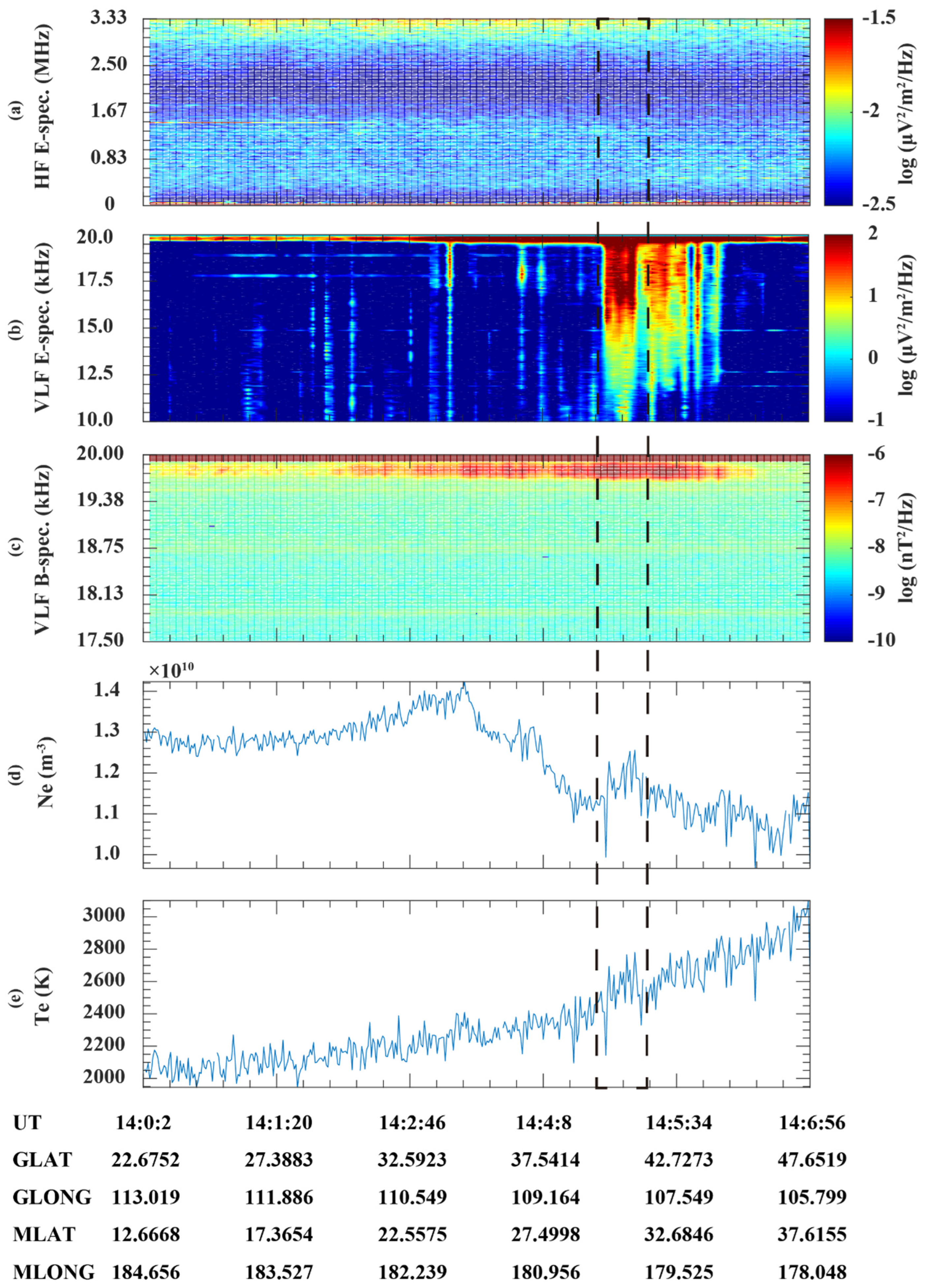Observations of Ionospheric Disturbances Produced by a Powerful Very-Low-Frequency Radio Signal in the Magnetic Conjugated Region Respect the Transmitter
Abstract
:1. Introduction
2. Data
3. Results
4. Discussion
5. Summary
Author Contributions
Funding
Data Availability Statement
Conflicts of Interest
References
- Bell, T.F.; Graf, K.; Inan, U.S.; Piddyachiy, D.; Parrot, M. DEMETER observations of ionospheric heating by powerful VLF transmitters. Geophys. Res. Lett. 2011, 38, L11103. [Google Scholar] [CrossRef] [Green Version]
- Wang, Y.L.; Zhang, X.M.; Shen, X.H. A study on the energetic electron precipitation observed by CSES. Earth Planet. Phys. 2018, 2, 538–547. [Google Scholar] [CrossRef]
- Parrot, M.; Sauvaud, J.A.; Berthelier, J.J.; Lebreton, J.P. First in-situ observations of strong ionospheric perturbations generated by a powerful VLF ground-based transmitter. Geophys. Res. Lett. 2007, 34, L11111. [Google Scholar] [CrossRef]
- Galejs, J. Ionospheric interaction of VLF radio waves. J. Atmos. Sol.-Terr. Phys. 1972, 34, 421–436. [Google Scholar] [CrossRef]
- Inan, U. VLF heating of the lower ionosphere. Geophys. Res. Lett. 1990, 17, 729–732. [Google Scholar] [CrossRef]
- Rodriguez, J.; Inan, U. Electron density changes in the nighttime D region due to heating by very-low-frequency transmitters. Geophys. Res. Lett. 1994, 21, 93–96. [Google Scholar] [CrossRef]
- Mishin, E.V.; Starks, M.J.; Ginet, G.P.; Quinn, R.A. Nonlinear VLF effects in the topside ionosphere. Geophys. Res. Lett. 2010, 37, L04101. [Google Scholar] [CrossRef]
- Graf, K.L.; Inan, U.S.; Piddyachiy, D.; Kulkarni, P.; Parrot, M.; Sauvaud, J.A. DEMETER observations of transmitter-induced precipitation of inner radiation belt electrons. J. Geophys. Res. 2009, 114, A07205. [Google Scholar] [CrossRef] [Green Version]
- Sidiropoulos, N.F.; Anagnostopoulos, G.; Rigas, V. Comparative study on earthquake and ground based transmitter induced radiation belt electron precipitation at middle latitudes. Nat. Hazards Earth Syst. Sci. 2011, 11, 1901–1913. [Google Scholar] [CrossRef]
- Sauvaud, J.A.; Moreau, T.; Maggiolo, R.; Treilhou, J.-P.; Jacquey, C.; Cros, A.; Coutelier, J.; Rouzaud, J.; Penou, E.; Gangloff, M. High-energy electron detection onboard DEMETER: The IDP spectrometer, description and first results on the inner belt. Planet. Space Sci. 2006, 54, 502–511. [Google Scholar] [CrossRef]
- Zhao, S.; Zhou, C.; Shen, X.H.; Zhima, Z. Investigation of VLF transmitter signals in the ionosphere by ZH-1 observations and full-wave simulation. J. Geophys. Res. Space Phys. 2019, 124, 4697–4709. [Google Scholar] [CrossRef]
- Li, M.; Parrot, M. Statistical analysis of the ionospheric ion density recorded by DEMETER in the epicenter areas of earthquakes as well as in their magnetically conjugate point areas. Adv. Space Res. 2018, 61, 974–984. [Google Scholar] [CrossRef]
- Lefeuvre, F.; Pincon, J.L.; Parrot, M. Midlatitude propagation of VLF to MF waves through nighttime ionosphere above powerful VLF transmitters. J. Geophys. Res. 2013, 118, 1210–1219. [Google Scholar] [CrossRef] [Green Version]
- Wang, L.W.; Shen, X.H.; Zhang, Y.; Zhang, X.G.; Hu, Z.; Yan, R.; Yuan, S.G.; Zhu, X.H. Developing progress of China Seismo-Electromagnetic Satellite project. Acta Seismol. Sin. 2016, 38, 376–385. [Google Scholar] [CrossRef]
- Cohen, M.B.; Inan, U.S. Terrestrial VLF transmitter injection into the magnetosphere. J. Geophys. Res. 2012, 117, A08310. [Google Scholar] [CrossRef] [Green Version]
- Gamble, R.J.; Rodger, C.J.; Clilverd, M.A.; Sauvaud, J.-A.; Thomson, N.R.; Stewart, S.L.; McCormick, R.J.; Parrot, M.; Berthelier, J.-J. Radiation belt electron precipitation by man-made VLF transmissions. J. Geophys. Res. 2008, 113, A10211. [Google Scholar] [CrossRef] [Green Version]
- Němec, F.; Pekař, J.; Parrot, M. NWC transmitter effects on the nightside upper ionosphere observed by a low-altitude satellite. J. Geophys. Res. Space Phys. 2020, 125, e2020JA028660. [Google Scholar] [CrossRef]
- Graf, K.L.; Lehtinen, N.G.; Spasojevic, M.; Cohen, M.B.; Marshall, R.A.; Inan, U.S. Analysis of experimentally validated trans-ionospheric attenuation estimates of VLF signals. J. Geophys. Res. 2013, 118, 2708–2720. [Google Scholar] [CrossRef] [Green Version]
- Parrot, M.; Zaslavski, Y. Physical mechanisms of man-made influences on the magnetosphere. Surv. Geophys. 1996, 17, 67–100. [Google Scholar] [CrossRef]
- Marshall, R.A. Effect of self-absorption on attenuation of lightning and transmitter signals in the lower ionosphere. J. Geophys. Res. Space Phys. 2014, 119, 4062–4076. [Google Scholar] [CrossRef]
- Omura, Y.; Nunn, D.; Matsumoto, H.; Rycroft, M.J. A review of observational, theoretical and numerical studies of VLF triggered emissions. J. Atmos. Terr. Phys. 1991, 53, 351–368. [Google Scholar] [CrossRef]
- Porkolab, M. Parametric processes in magnetically confined CTR plasmas. Nucl. Fusion 1978, 18, 367. [Google Scholar] [CrossRef]
- Labno, A.; Pradipta, R.; Lee, M.C.; Sulzer, M.P.; Burton, L.M.; Cohen, J.A.; Kuo, S.P.; Rokusek, D.L. Whistler-mode wave interactions with ionospheric plasmas over Arecibo. J. Geophys. Res. 2007, 112, A03306. [Google Scholar] [CrossRef] [Green Version]
- Pradipta, R.; Rooker, L.A.; Whitehurst, L.N.; Lee, M.C.; Ross, L.M.; Sulzer, M.P.; Gonzalez, S.; Tepley, C.; Apontre, N.; See, B.Z.; et al. Whistler wave-induced ionospheric plasma turbulence: Source mechanisms and remote sensing. J. Atmos. Sol.-Terr. Phys. 2013, 103, 169–175. [Google Scholar] [CrossRef]





Disclaimer/Publisher’s Note: The statements, opinions and data contained in all publications are solely those of the individual author(s) and contributor(s) and not of MDPI and/or the editor(s). MDPI and/or the editor(s) disclaim responsibility for any injury to people or property resulting from any ideas, methods, instructions or products referred to in the content. |
© 2023 by the authors. Licensee MDPI, Basel, Switzerland. This article is an open access article distributed under the terms and conditions of the Creative Commons Attribution (CC BY) license (https://creativecommons.org/licenses/by/4.0/).
Share and Cite
Feng, T.; Liu, M.; Zhou, C. Observations of Ionospheric Disturbances Produced by a Powerful Very-Low-Frequency Radio Signal in the Magnetic Conjugated Region Respect the Transmitter. Remote Sens. 2023, 15, 3307. https://doi.org/10.3390/rs15133307
Feng T, Liu M, Zhou C. Observations of Ionospheric Disturbances Produced by a Powerful Very-Low-Frequency Radio Signal in the Magnetic Conjugated Region Respect the Transmitter. Remote Sensing. 2023; 15(13):3307. https://doi.org/10.3390/rs15133307
Chicago/Turabian StyleFeng, Ting, Moran Liu, and Chen Zhou. 2023. "Observations of Ionospheric Disturbances Produced by a Powerful Very-Low-Frequency Radio Signal in the Magnetic Conjugated Region Respect the Transmitter" Remote Sensing 15, no. 13: 3307. https://doi.org/10.3390/rs15133307
APA StyleFeng, T., Liu, M., & Zhou, C. (2023). Observations of Ionospheric Disturbances Produced by a Powerful Very-Low-Frequency Radio Signal in the Magnetic Conjugated Region Respect the Transmitter. Remote Sensing, 15(13), 3307. https://doi.org/10.3390/rs15133307






